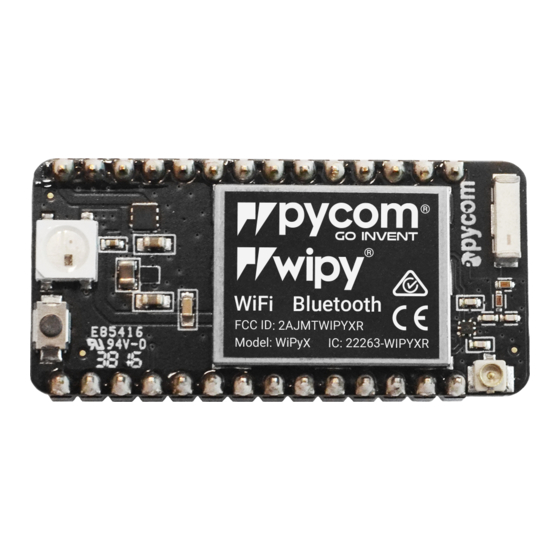
Summarization of Contents
1. Getting Started Guide
1.0 Introduction to Getting Started
Overview of the guide's purpose and initial setup steps for Pycom modules.
1.1 Hardware Setup Guide
Detailed instructions on connecting Pycom modules to hardware.
1.2 Software Setup Guide
Information on necessary software tools for Pycom development.
1.3 Programming Modules Guide
Guides on using MicroPython and Pymakr for programming modules.
1.4 Device Registration Procedures
Procedures for registering devices for network features.
2. Pymakr Plugin Setup
2.1 Pymakr Plugin Installation
Steps to install the Pymakr plugin for Atom and Visual Studio Code.
2.2 Pymakr Tools and Features
Overview of Pymakr's console, run, upload, and project features.
2.3 Pymakr Settings Configuration
Description of various settings available for the Pymakr plugin.
3. Pysense and Pytrack Boards
3.1 Pysense and Pytrack Introduction
Introduction to Pytrack and Pysense boards and their sensors.
3.2 Installing Software for Boards
Guide to installing software and checking for library updates.
3.3 API Reference for Boards
Documentation for Pytrack and Pysense board APIs and sensor libraries.
4. Tutorials and Examples
4.1 Tutorials Introduction
Overview of tutorials and examples for Pycom modules.
4.2 All Pycom Device Examples
Generic examples applicable to all Pycom devices and expansion boards.
4.3 LoRa Module Examples
Tutorials demonstrating LoRa functionality on the LoPy module.
4.4 Sigfox Module Examples
Tutorials for registering and getting started with SiPy for Sigfox.
4.5 LTE Module Examples
Tutorials for LTE CAT-M1 and NB-IoT functionality on cellular modules.
4.6 Pytrack Examples
Examples specific to using the Pytrack's accelerometer.
4.7 Pysense Examples
Basic example for reading pitch and roll from Pysense accelerometer.
5. Firmware and API Reference
5.1 MicroPython Modules Introduction
Overview of standard Python, MicroPython-specific, and Pycom modules.
5.2 Pycom Modules Reference
Details on modules specific to Pycom devices and their implementations.
5.3 MicroPython Modules Reference
List of standard Python, MicroPython-specific, and Pycom modules.
6. Product Information
6.0 Product Info Introduction
Overview of information pages for each product.
6.1 Development Modules Datasheets
Datasheets for Pycom Development Devices: WiPy, LoPy, SiPy, GPy, FiPy.
7.2 OEM Module Datasheets
Datasheets for Pycom OEM Devices: W01, L01, L04, G01.
7.3 Expansion Board and Shield Datasheets
Datasheets for Pycom Expansion Boards and Shields.
8. Pybytes IoT Ecosystem
8.1 Pybytes Introduction
Introduction to Pybytes, an IoT ecosystem for Pycom devices.
8.2 Getting Started with Pybytes
Step-by-step guide to creating a Pybytes account.
8.3 Adding a Device to Pybytes
Wizard and steps to add a Pycom device to Pybytes.
8.4 Visualising Device Data on Pybytes
Guide to creating widgets and setting up device dashboards on Pybytes.
9. Documentation Notes
9.1 Documentation Introduction
Explains documentation clarity and adherence to Python standards.
9.2 Documentation Syntax
Details on syntax conventions: arguments, methods, and constants.
9.3 REPL vs Scripts Comparison
Compares code execution behavior in MicroPython REPL versus scripts.
10. Advanced Topics
10.1 Firmware Downgrade Procedures
Methods for downgrading a device's firmware version.
10.2 CLI Updater Utility
Instructions for using the command-line update utility for platforms.
10.3 Secure Boot and Flash Encryption
Steps for using secure boot and flash encryption for firmware.
11. License Information
11.1 MicroPython License
MicroPython (MIT) and Pycom Limited (GNU GPL) license details.






Need help?
Do you have a question about the FiPy and is the answer not in the manual?
Questions and answers